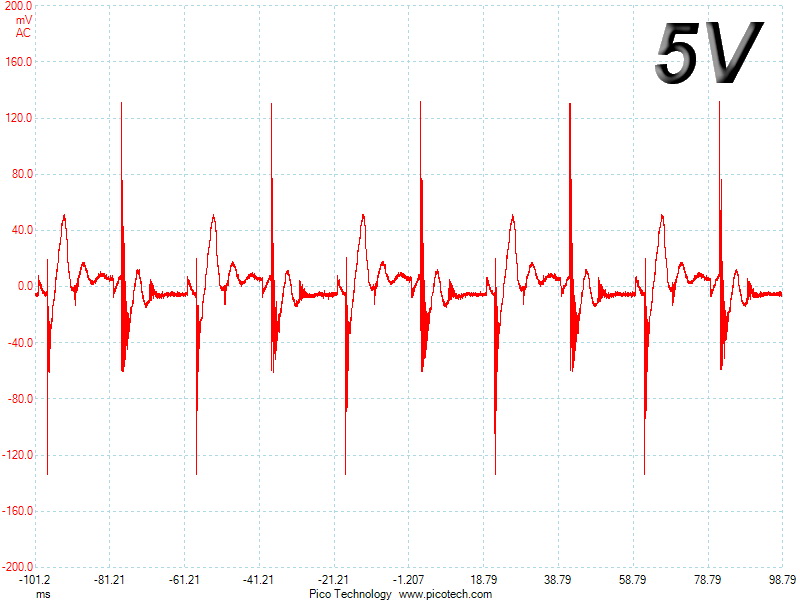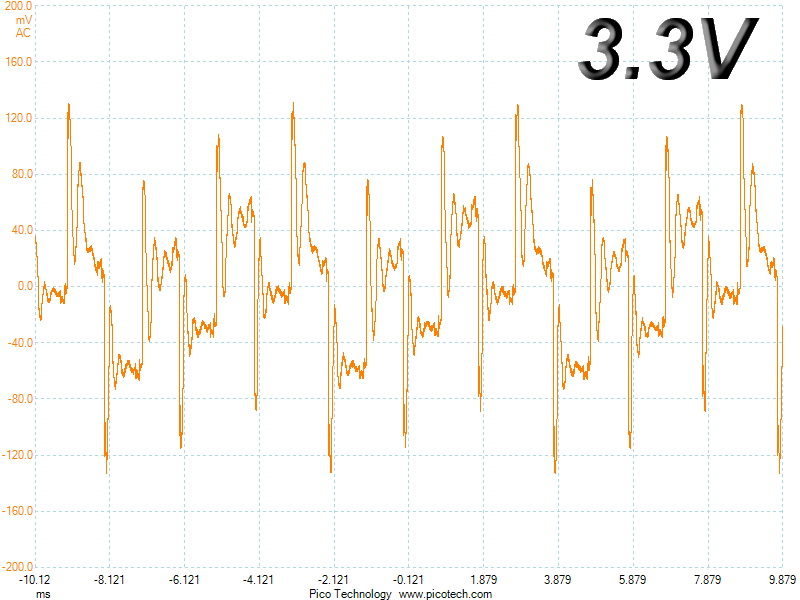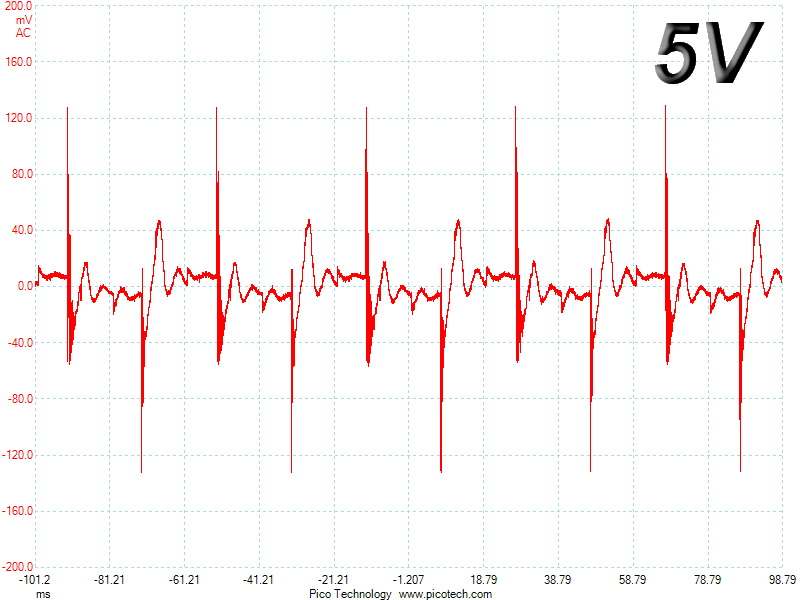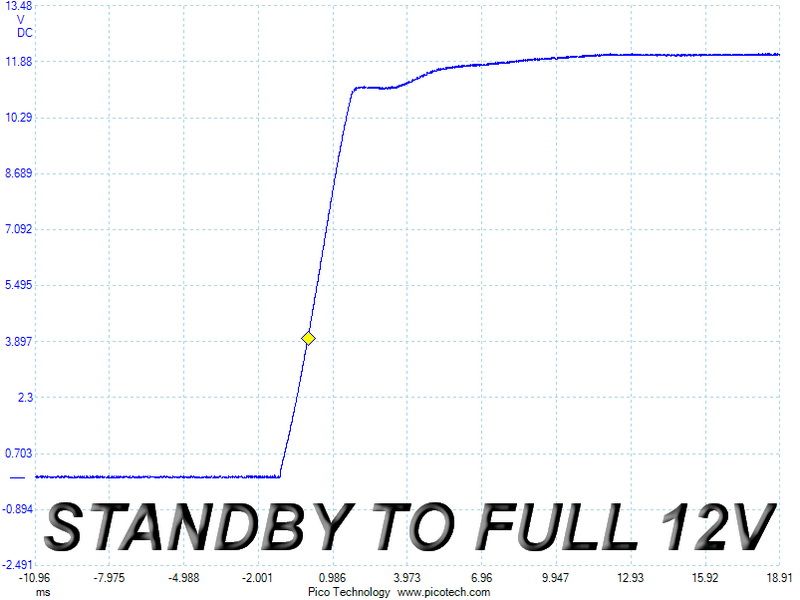EVGA SuperNOVA 850 G3 PSU Review
EVGA refreshed its popular G2 PSU family with the G3 one using Super Flower's Leadex II platform. The 850 G3 is the second strongest member in this line-up, offering high performance and a depth of just 15cm.
Why you can trust Tom's Hardware
Transient Response Tests
Advanced Transient Response Tests
For details on our transient response testing, please click here.
Ιn these tests, we monitor the 850 G3's response in several scenarios. First, a transient load (10A at +12V, 5A at 5V, 5A at 3.3V, and 0.5A at 5VSB) is applied for 200ms as the PSU works at 20 percent load. In the second scenario, it's hit by the same transient load while operating at 50 percent load.
In the next sets of tests, we increase the transient load on the major rails with a new configuration: 15A at +12V, 6A at 5V, 6A at 3.3V, and 0.5A at 5VSB. We also increase the load-changing repetition rate from 5 Hz (200ms) to 50 Hz (20ms). Again, this runs with the PSU operating at 20 and 50 percent load.
The last tests are even tougher. Although we keep the same loads, the load-changing repetition rate rises to 1 KHz (1ms).
In all of the tests, we use an oscilloscope to measure the voltage drops caused by the transient load. The voltages should remain within the ATX specification's regulation limits.
These tests are crucial because they simulate the transient loads a PSU is likely to handle (such as booting a RAID array or an instant 100 percent load of CPU/GPUs). We call these "Advanced Transient Response Tests," and they are designed to be very tough to master, especially for a PSU with a capacity of less than 500W.
Advanced Transient Response at 20 Percent – 200ms
| Voltage | Before | After | Change | Pass/Fail |
|---|---|---|---|---|
| 12V | 12.054V | 12.002V | 0.43% | Pass |
| 5V | 4.989V | 4.879V | 2.20% | Pass |
| 3.3V | 3.316V | 3.206V | 3.32% | Pass |
| 5VSB | 5.067V | 5.029V | 0.75% | Pass |
Advanced Transient Response at 20 Percent – 20ms
| Voltage | Before | After | Change | Pass/Fail |
|---|---|---|---|---|
| 12V | 12.053V | 11.970V | 0.69% | Pass |
| 5V | 4.990V | 4.855V | 2.71% | Pass |
| 3.3V | 3.315V | 3.188V | 3.83% | Pass |
| 5VSB | 5.067V | 5.033V | 0.67% | Pass |
Advanced Transient Response at 20 Percent – 1ms
| Voltage | Before | After | Change | Pass/Fail |
|---|---|---|---|---|
| 12V | 12.052V | 11.973V | 0.66% | Pass |
| 5V | 4.989V | 4.878V | 2.22% | Pass |
| 3.3V | 3.315V | 3.182V | 4.01% | Pass |
| 5VSB | 5.067V | 5.022V | 0.89% | Pass |
Advanced Transient Response at 50 Percent – 200ms
| Voltage | Before | After | Change | Pass/Fail |
|---|---|---|---|---|
| 12V | 12.036V | 11.977V | 0.49% | Pass |
| 5V | 4.987V | 4.880V | 2.15% | Pass |
| 3.3V | 3.313V | 3.209V | 3.14% | Pass |
| 5VSB | 5.046V | 5.007V | 0.77% | Pass |
Advanced Transient Response at 50 Percent – 20ms
| Voltage | Before | After | Change | Pass/Fail |
|---|---|---|---|---|
| 12V | 12.036V | 11.951V | 0.71% | Pass |
| 5V | 4.987V | 4.854V | 2.67% | Pass |
| 3.3V | 3.313V | 3.195V | 3.56% | Pass |
| 5VSB | 5.046V | 5.031V | 0.30% | Pass |
Advanced Transient Response at 50 Percent – 1ms
| Voltage | Before | After | Change | Pass/Fail |
|---|---|---|---|---|
| 12V | 12.035V | 11.955V | 0.66% | Pass |
| 5V | 4.987V | 4.869V | 2.37% | Pass |
| 3.3V | 3.313V | 3.194V | 3.59% | Pass |
| 5VSB | 5.045V | 4.995V | 0.99% | Pass |





The transient response of the +12V rail is great, as is usually the case in Super Flower's high-end platforms. The 5V and 5VSB rails do pretty well. Only the 3.3V rail exceeds the 3% range. Still, it manages to successfully pass all of our tests.
Get Tom's Hardware's best news and in-depth reviews, straight to your inbox.
Here are the oscilloscope screenshots we took during Advanced Transient Response Testing:
Transient Response At 20 Percent Load – 200ms




Transient Response At 20 Percent Load – 20ms




Transient Response At 20 Percent Load – 1ms




Transient Response At 50 Percent Load – 200ms




Transient Response At 50 Percent Load – 20ms




Transient Response At 50 Percent Load – 1ms




Turn-On Transient Tests
In the next set of tests, we measure the PSU's response in simpler transient load scenarios—during its power-on phase.
For the first measurement, we turned the SuperNOVA 850 G3 off, dialed in the maximum current the 5VSB could output and switched the PSU back on. In the second test, we dialed the maximum load the +12V could handle and started the 850W supply while it was in standby mode. In the last test, while the PSU was completely switched off, we dialed the maximum load the +12V rail could handle before switching it back on from the loader and restoring the power. The ATX specification states that recorded spikes on all rails should not exceed 10 percent of their nominal values (+10 percent for 12V is 13.2V, and 5.5 V for 5V).



We observe a really small voltage overshoot at 5VSB and smooth slopes in the other two tests. Overall, this is pretty good performance.
Current page: Transient Response Tests
Prev Page Cross-Load Tests And Infrared Images Next Page Ripple Measurements
Aris Mpitziopoulos is a contributing editor at Tom's Hardware, covering PSUs.
-
envy14tpe Made by Super Flower? Love the quality SF produces. Can't wait to buy my new Leadex II.Reply -
powernod For those looking for an "80+ Gold efficient PSU", probably they won't have to look elsewhere. LeadexII seems amazing platform!!Reply -
BugariaM Based on the information from EVGA siteReply
Such an aggressive fan curve is only made on 1000W and 850W units of the G3 series
550W, 650W and 750W - have a much smoother relaxed curve
I'm curious, what is the fan curve for the 850W unit when the ECO mode is off? It is possible that in this mode it will be much quieter at normal load... -
waylo Dangit. Just bought this yesterday, focusing on a quiet PSU, deciding on this over the G2 or P2 version. I know the quality will be there, but disappointed in the noise levels.Reply -
Virtual_Singularity Excellent, impressively thorough and professional review, as usual. Much appreciated.Reply -
Stone Cold Reply
So you are saying this PSU is miles better than the Seasonic prime?!19439055 said:Ahh, SuperFlower. I don't know why people buy anything else.